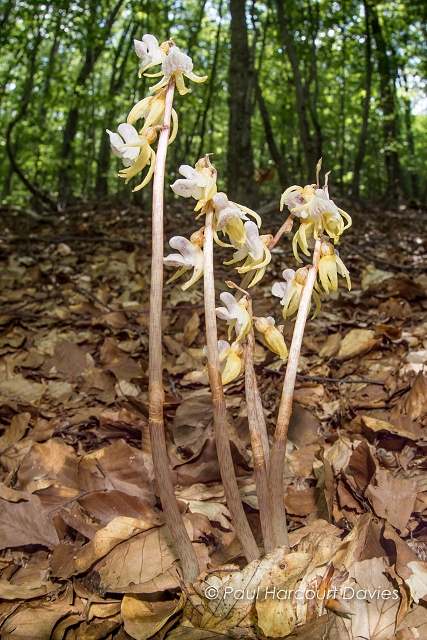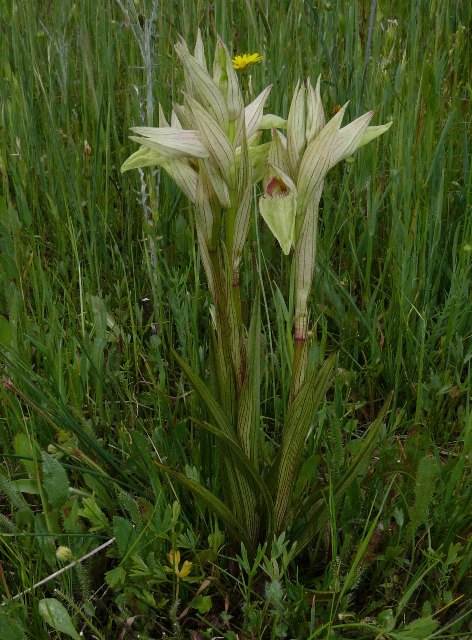Ghost of a Chance - Sue Parker seeks an Algarve rarity that seems to be afflicted with Brigadoon syndrome
Based on an article by Sue Parker in Algarve Resident, March 2017. Algarve Resident is the leading English-language newspaper and the source of essential information for Residents and would-be Residents in the Algarve.
For more information about Algarve Resident...
Mentioning the word orchid tends to conjure up visions of steamy jungles and large exotic flowers. Like yin and yang or steak and kidney, the words orchid and rare are commonly associated. Interestingly neither of these stereotypes is really justified. It’s true that many orchids do grow in tropical jungles and some are indeed rare, but what those not afflicted with orchid mania (whose symptoms are similar to those suffered by bird twitchers) fail to appreciate is that, with a few frozen-zone exceptions, wild orchids can be found all over the planet’s land mass. In some places orchids can rightly be described as ‘common as muck’. Here in the Algarve we have close on 40 wild orchid species, many of which can be seen in great abundance if you know where to look; however some of our orchids are indeed rare - a few extremely so.

The Ghost Orchid Epipogium aphyllum - picture Paul Harcourt Davies
Most orchid enthusiasts, particularly those who once lived or still do live in Britain, are familiar with the story of the Ghost Orchid Epipogium aphyllum. First discovered in England in 1854 by a Mrs Anderton Smith near the village of Tedstone Delamere, in Herefordshire, and then seen again in 1876 near Ludlow, this attractive but extremely hard to spot orchid has probably always been rare wherever it occurs. In fact its range extends from Western Europe as far east as Japan, but nowhere can it be described as ‘carpeting the ground’.
Over the intervening years this orchid all but disappeared from the few places where it occurred in Britain, and for some orchidomaniacs the quest to rediscover it became an obsession. After no sightings for two decades, in 2005 the Ghost Orchid was officially regarded as extinct in Britain. Then, in 2009, one solitary specimen of this remarkable wildflower was found - again in Herefordshire - an event that created huge interest in orchid circles worldwide.

The red-veined form of Serapias perez-chiscanoi - Photograph Gerry Trask
Here in the Algarve, along with our common and not so common orchids we also have our own ‘ghost’ orchid. Although not closely related to Epipogium aphyllum, its luminous white spectral colouring and elusive occurrence make it a source of fascination to those interested in the Portuguese flora. It is, in fact, a tongue orchid. We have several tongue-orchid species in the Algarve; they are usually dark red, orange or yellow; and they occur in a variety habitats.
Serapias perez-chiscanoi is a rare Iberian Peninsula endemic, and there have been only two reports of its presence in the Algarve. In 1993 a small colony was discovered, but it subsequently disappeared, and there is one further report dating from 2009. This very rare orchid comes in two forms: one form has green leaves and stems and pale white flowers with a greenish tinge and darker green veining, while a second form also has white flowers but has red markings on the leaves, stem and flowers. Each plant can have up to 13 flowers. Adding further to the confusion, intermediates between the two forms occur.
Discovered in 1976 by Spanish botanist José Luis Pérez Chiscano in the Guadiana River basin, the plants were thought to be nothing more than ‘deviant’ tongue orchids, but after twelve years of study Serapias perez-chiscanoi was eventually accepted as a separate species. Efforts to find more colonies have revealed about 30 sites in Extremadura, Spain, and in parts of Portugal. As with so many wild orchids, ‘here today, gone tomorrow’ best describes the unpredictability of most of these colonies.
Serapias perez-chiscanoi grows in slightly acid damp or marshy grassland. The Algarve has little of this habitat intact, but it is definitely worth keeping an eye out for this orchid if you find the right type of environment on your countryside walks. It flowers for about three weeks but the timing, between late March and early May, is very dependent on spring rainfall and temperature.

The green-veined form of Serapias perez-chiscanoi - Photograph Gerry Trask
Here in the Algarve, we are blessed with magnificent spring flower displays, and in some places our wild orchids occur in large colonies – for example, pink Pyramidal Orchids can literally carpet the ground on suitable sites. Orchids are very particular about their habitats and many can only grow if the conditions are just right. At the moment they are hanging on, but with burgeoning tourist developments throughout the region the kinds of habitats that wild orchids require are being seriously depleted, and so the survival of several of these iconic wildflowers is seriously threatened. Many of the early spring visitors to the Algarve come here to enjoy the beautiful countryside, its wildflowers and wildlife, and we must be careful that in striving to accommodate more and more visitors we do not destroy the very things that they come to see.
In the meantime while you are out walking in our wonderful world, do please keep a look out for white-flowered tongue orchids – there’s just a ghost of a chance that you might stumble on something very rare and special indeed.

